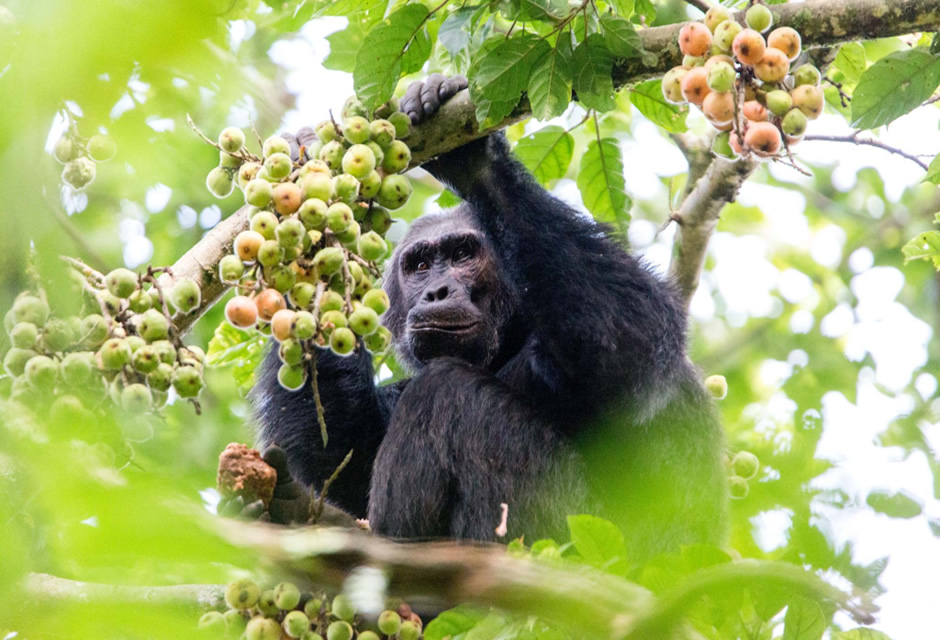A few people have got a privilege to track the mighty rare mountain gorillas and chimpanzees in the rain forests of Rwanda and Uganda. A face to face encounter with these endangered great apes in their natural habitat is a truly thrilling experience. That is why they are our closest living relative that makes getting up close to them so moving and awe-inspiring. We may be among the last generations ever to have the chance to breathe the same air as these highly intelligent, social and elusive animals.
It is always interesting to look at these primates because of their fascinating behaviors figured out by their intelligence. Among all the members of the Kingdom Animalia, chimpanzees and gorillas come next to humans and they share 99% of human DNA, in the brain sizes compared to the body.
Chimpanzee Encounters
Chimpanzees are essentially inhabitants of the western rain forest, but their range does extend into the extreme west of Tanzania, Rwanda, and Uganda, which have combined population of perhaps 7,000 individuals. These are concentrated in Tanzania’s Mahale and Gombe national parks, Rwanda’s Nyungwe forest National Park, and Uganda’s national parks and other reserves, most notably Budongo, Kibale, Semuliki, Maramagambo and Bwindi. Although East Africa’s chimps represent less than 3% of the global population, much of what is known about wild chimpanzee society and behavior stems from the region, in particular the ongoing research projects initiated in Gombe stream and Mahale Mountain National park back in the 1960s.
Chimpanzee lives predominantly in moist and dry forests extending into savanna woodlands. Their diet is omnivorous – about half of it is fruit, with vegetation, bark, small mammals and even honey making up the rest. What they eat varies according to where they live and the seasons. Interestingly, these highly intelligent great apes eat plants with medicinal properties to self-medicate themselves.
Not only do they have opposable thumbs like ours, they also have opposable big toes so they can grasp things with their hands and feet. A little-known but fascinating fact is that groups of chimpanzees living in different regions have unique behaviors, tools and traditions that are passed down from one generation to the next. They are highly sociable creatures that live in communities that can include as many as 120 individuals. Chimpanzee communicates by using vocalizations, hand gestures and facial expressions.
Unlike most other primates, chimpanzees don’t live in troops, but instead from extended communities of up to 100 individuals which roam the forest in small, socially mobile subgroups that often revolve around a few close family members such as brothers or a mother and daughter. Male chimps normally spend their entire life within the community.
Gorilla Encounters
Among all the primates, gorilla is the largest. They range in Central and Western Africa and there are only two species of gorilla, named Western (Gorilla gorilla) and Eastern (Gorilla beringei). Eastern gorilla ranges in some Central African countries that is; Uganda, DRC and Rwanda, while Western gorillas range in Cameroon, Nigeria, Angola, etc.
The popular mountain gorillas are protected in the Virunga Area and the Bwindi Sarambwe Forest in Uganda, Rwanda and DR Congo. Their habitat includes tropical to subtropical forests. Adult males are called silver backs, and they are 1.5 -1.8 meters tall, weigh between 140 and 200 kilograms. Usually, an adult female is about half of the size of a silver back. The structure of the skull demonstrates the characteristic mandibular prognathous, which the protrusion of mandible farther is out than the maxilla. They depend on an herbivorous diet that consists mainly of fruits. The coat colour is dark, which is mostly blackish brown.
Equally fascinating is the extent to which the gorillas try to interact with their visitors, often approaching them, and occasionally touching one of the guides in apparent recognition and greeting as they walk past. The magical hour with the gorillas is expensive and getting there can sometimes be hard work. The hike up to the mountain gorillas involves a combination of steep slopes, dense vegetation, slippery underfoot condition after rain, and high attitude. For all that, the more accessible gorilla groups can be visited by reasonably fit adults of any age on their gorilla safaris in Rwanda, and in 20 years of African travel.
Social Behavior
In both gorillas and chimpanzees, posturing has communicative significance in the behavior of dominant males. Dominant male gorilla leaders move force- fully, and “stand and face” when they want the group to move off. Most chimpanzee groups have no leaders, but some Male groups have an especially dominant male which leads the way across roads and leaves feeding trees first; dominant males seen in other types of group as well, being distinguished by forceful movements and fine physique. The role of facial expressions was difficult to determine in both species; each, however, exhibited teeth and gums in strongly disturbing situations.
Vocalizations present an area of extreme contrast gorilla’s chimpanzees. While gorillas are normally rather quiet, chimpanzees are among the noisiest animals and you will witness this on a trek through the forests in Uganda that host these apes. Most gorilla sounds are abrupt and of a low intensity when they are undisturbed; their most intense vocalization, the roar, is given to man, or when otherwise greatly excite. Twenty-one more or less distinct free- living gorillas, of which eight were fairly common. In the chimpanzee, 11 more or less distinct vocalizations were common. Of these, one type-call which is prolonged and high pitched and maybe called hoots-are emitted by several animals together, a phenomenon which does not occur in gorillas. The resulting chorus is extraordinarily loud and has a carrying power of up to two miles.

Leave a Reply